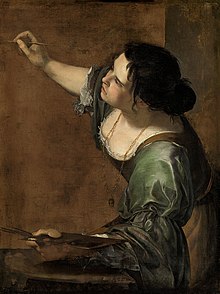
Back أرتيميسا جنتلسكي Arabic Artemisia Gentileschi AST Artemisia Gentileschi AVK Artemisa Centileski Azerbaijani Artemisia Gentileschi BCL Артэмізія Джэнтылескі Byelorussian Артемизия Джентилески Bulgarian Artemisia Gentileschi Breton Artemisia Gentileschi Catalan Artemisia Gentileschiová Czech
Artemisia Gentileschi | |
|---|---|
 | |
| Born | 8 July 1593 |
| Died | c. 1656 |
| Resting place | Unknown |
| Nationality | Italian |
| Known for | Painting |
| Notable work | |
| Style | Baroque |
| Movement | Accademia delle Arti del Disegno |
| Children | 5 |
| Patron(s) | |
| Signature | |
Artemisia Lomi or Artemisia Gentileschi (US: /ˌdʒɛntiˈlɛski/,[1][2] Italian: [arteˈmiːzja dʒentiˈleski]; 8 July 1593 – c. 1656) was an Italian Baroque painter. Gentileschi is considered among the most accomplished 17th-century artists, initially working in the style of Caravaggio. She was producing professional work by the age of 15.[3] In an era when women had few opportunities to pursue artistic training or work as professional artists, Gentileschi was the first woman to become a member of the Accademia di Arte del Disegno in Florence and she had an international clientele.[4][5]
Many of Gentileschi's paintings feature women from myths, allegories, and the Bible, including victims, suicides, and warriors.[6] Some of her best known subjects are Susanna and the Elders (particularly the 1610 version in Pommersfelden), Judith Slaying Holofernes (her 1614–1620 version is in the Uffizi gallery), and Judith and Her Maidservant (her version of 1625 is in the Detroit Institute of Arts).

Gentileschi was known for being able to depict the female figure with great naturalism and for her skill in handling colour to express dimension and drama.[7][8][9][10]
Her achievements as an artist were long overshadowed by the story of Agostino Tassi raping her when she was a young woman and Gentileschi being tortured to give evidence during his trial.[11] For many years Gentileschi was regarded as a curiosity, but her life and art have been reexamined by scholars in the 20th and 21st centuries, with the recognition of her talents exemplified by major exhibitions at internationally esteemed fine art institutions, such as the National Gallery in London.[12]
- ^ "Gentileschi". The American Heritage Dictionary of the English Language (5th ed.). HarperCollins. Retrieved 31 May 2019.
- ^ "Gentileschi". Merriam-Webster.com Dictionary. Retrieved 31 May 2019.
- ^ Garrard (1989), p. 13.
- ^ Cite error: The named reference
Gunnellwas invoked but never defined (see the help page). - ^ Bissell (1999), p. 42.
- ^ Cite error: The named reference
Lubbockwas invoked but never defined (see the help page). - ^ Cavazzini, Patrizia (2001). "Artemisia in Her Father's House". In Christiansen, W. Keith (ed.). Orazio and Artemisia Gentileschi. New York City: Metropolitan Museum of Art. pp. 283–295. ISBN 978-0300090772.
- ^ Garrad, Mary D. (March 1980). "Artemisia Gentileschi's Self Portrait as the Allegory of Painting". The Art Bulletin. 62 (1). London, England: Taylor & Francis: 97–112. doi:10.1080/00043079.1980.10787729.
- ^ Modesti, Adelina (2018). "'Il Pennello Virile': Elisabetta Sirani and Artemisia Gentileschi as Masculinized Painters?". In Barker, Shelia (ed.). Artemisia Gentileschi in a Changing Light. London, England: Harvey Miller Publishers. ISBN 978-1909400894.
- ^ Locker, Jesse (2015). "Artemisia in the Eyes of the Neapolitan Poets". Artemisia Gentileschi: The Language of Painting. New Haven, Connecticut: Yale University Press. ISBN 978-0300185119.
- ^ Cohen (2000).
- ^ Davis-Marks, Isis (2 October 2020). "Why a Long-Awaited Artemisia Gentileschi Exhibition Is So Significant". Smithsonian.
© MMXXIII Rich X Search. We shall prevail. All rights reserved. Rich X Search